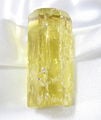Beryl

Beryl is a mineral with the chemical name beryllium aluminum cyclosilicate (chemical formula Be3Al2(SiO3)6). It has a vitreous (glassy) luster and can be transparent or translucent. Pure beryl is colorless, but it is frequently tinted by the presence of impurities. Possible colors are green, blue, yellow, red, and white. The name "beryl" comes from the Greek word beryllos, referring to the "precious blue-green color of sea water." Several varieties of beryl are valuable gemstones, such as emerald and aquamarine.
Characteristics
Beryl has a hexagonal crystalline structure and exhibits conchoidal fracture. The crystals may range in size from very small up to several meters in width. This mineral has a hardness of 7.5-8, and its specific gravity (density relative to that of pure water) is 2.63-2.80.
Varieties
Varieties of beryl have been considered gemstones since prehistoric times. Green beryl is called emerald; red beryl is bixbite, red emerald, or scarlet emerald; blue beryl is aquamarine; pink beryl is morganite; white beryl is goshenite; and a clear, bright yellow beryl is called golden beryl. Other shades, such as yellow-green for heliodor and honey yellow are also common. Red beryl is extremely rare and is not used in jewelry as it forms tiny crystals. Blue beryl (aquamarine) fades in color when exposed to sunlight.
Occurrence
Beryl is found most commonly in granitic pegmatites, but it also occurs in mica schists in the Ural Mountains and is often associated with tin and tungsten orebodies. Beryl is found in certain European countries such as Austria, Germany, and Ireland. It (especially morganite) is also found in Madagascar.
The most famous source of emeralds in the world is at Muzo and Chivor, Boyacá, Colombia, where they make a unique appearance in limestone. Emeralds are also found in the Transvaal, South Africa; Minas Gerais, Brazil; and near Mursinka in the Ural mountains. In the United States, emeralds are found in North Carolina. New England's pegmatites have produced some of the largest beryls known, including a massive crystal with dimensions 5.5 m by 1.2 m (18 ft by 4 ft) with a mass of around 18 metric tons. Other beryl locations include South Dakota, Colorado, Utah, Idaho, and California.
Applications
Massive beryl is a primary ore of the metal beryllium. In addition, as noted above, several varieties are valued as gemstones.
Cultural and historical trivia
- Recognizing the beauty of beryl, a biblical passage (Ezekiel 1:16) describes the wheels of God's throne as having the appearance of "gleaming beryl."
- The earliest crystal balls were made from beryl, later being replaced by rock crystal.
- The Scottish called them âstones of power.â
- The druids (the priestly class in ancient Celtic societies) used beryl for scrying (crystal gazing).
Image gallery
Beryl var. emerald.
Beryl var. aquamarine, from Brazil.
Beryl produced in Tajikistan.
See also
ReferencesISBN links support NWE through referral fees
- Farndon, John. The Practical Encyclopedia of Rocks & Minerals: How to Find, Identify, Collect and Maintain the World's best Specimens. Lorenz Books, 2006. ISBN 0754815412
- Hurlbut, Cornelius S., and Cornelis Klein. Manual of Mineralogy, 20th ed.. New York, NY: John Wiley and Sons, 1985. ISBN 0-471-80580-7
- Pellant, Chris. Smithsonian Handbooks: Rocks and Minerals. New York, NY: DK Adult, 2002. ISBN 0789491060
- Shaffer, Paul R., Herbert S. Zim, and Raymond Perlman. Rocks, Gems and Minerals, Revised and Updated edition. St. Martin's Press, Golden Guide, 2001. ISBN 1582381321
- Sinkankas, John. Emerald & Other Beryls. Geoscience Press, 1994. ISBN 0-8019-7114-4
External links
All links retrieved September 29, 2023.
Credits
New World Encyclopedia writers and editors rewrote and completed the Wikipedia article in accordance with New World Encyclopedia standards. This article abides by terms of the Creative Commons CC-by-sa 3.0 License (CC-by-sa), which may be used and disseminated with proper attribution. Credit is due under the terms of this license that can reference both the New World Encyclopedia contributors and the selfless volunteer contributors of the Wikimedia Foundation. To cite this article click here for a list of acceptable citing formats.The history of earlier contributions by wikipedians is accessible to researchers here:
The history of this article since it was imported to New World Encyclopedia:
Note: Some restrictions may apply to use of individual images which are separately licensed.




